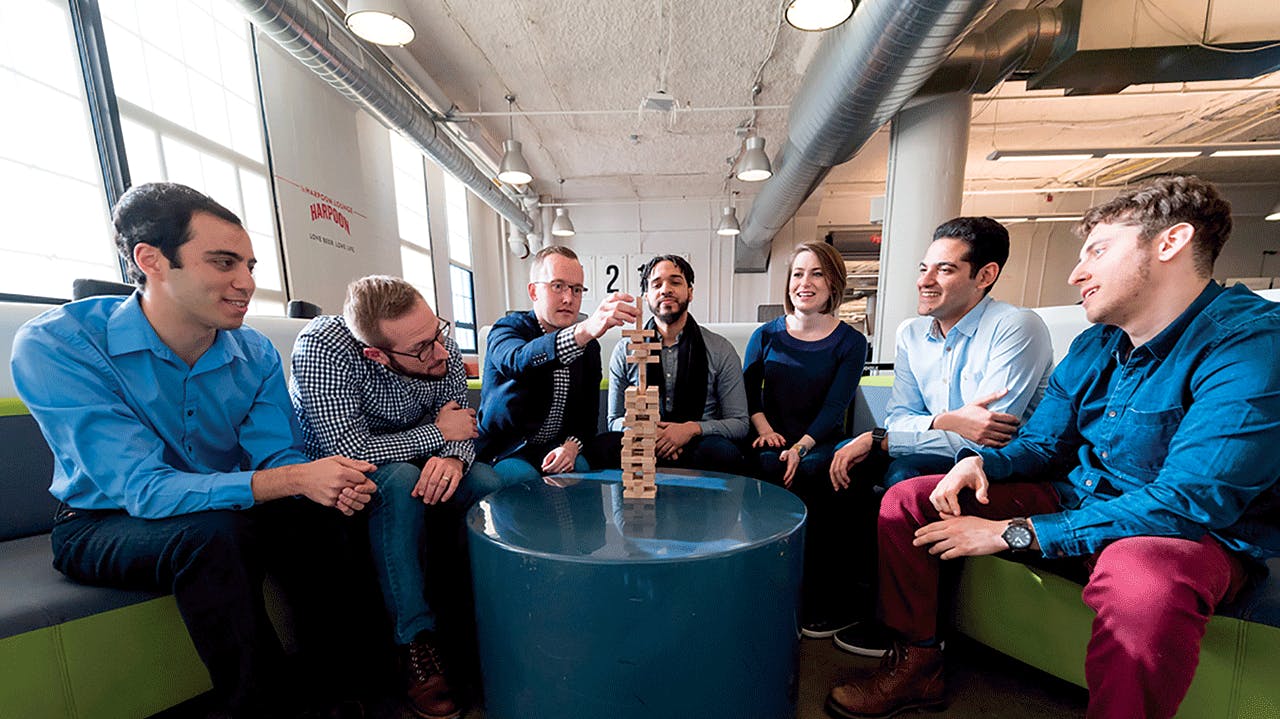Low wages, economic scarcity, and growing income inequality aside, millennials actually have it pretty good when it comes to one aspect of money: online banking. No longer do you need to find an ATM to see your checking balance—it’s as simple as logging into your account or looking at an app. Ditto for depositing paychecks. Rather than slogging to the nearest branch, a smartphone picture of a check is often just as good as a physical deposit.
There’s already an overwhelming number of online lenders (and platforms that match borrowers to them). It may seem like the only reason to visit a physical bank anymore is to deposit cash, but with even Chase Bank removing coin-counting machines from its branches, the banks themselves don’t seem to be betting on it. Some, like Simple.com, don’t even offer any brick-and-mortar locations—they exist only as a website and an app.
This is what we mean by the advance of financial technology, or fintech—defined by the Wharton FinTech club as “an economic industry composed of companies that use technology to make financial systems more efficient.” Even more succinctly, it’s tech companies that offer products and services to make dealing with money easier. Intuit, which owns TurboTax and QuickBooks, is a fintech company. But so are Stripe (which allows merchants to accept online and mobile payments) and Oscar (which specializes in selling Obamacare-style insurance plans).
Fintech is a really diverse industry. And for the past few years, it’s been focusing more and more on bringing charity up to speed with the rest of the financial world.
On the donor side, the words “charity” and “philanthropy” still conjure images of stuffy black-tie galas and wealthy blue bloods writing checks for tax deductions. Perhaps monocles are involved. On the nonprofit administration side, there’s beleaguered do-gooders drowning in a sea of paperwork—integral to, yet in the way of, their passion for, say, providing aid to developing countries. Fortunately, fintech products are making charitable donations easier for donors and nonprofits alike, and empowering the millennial generation to be involved like never before.
According to the software company Blackbaud’s 2015 Charitable Giving Report, over 93 percent of charitable donations are still made by cash or check. But “over the next 10 years, donations will move online,” predicted Bstow founder Jason Grad. “As they do, the social sector will be revitalized through sustained growth led by millennial philanthropic leaders and entrepreneurs who step up to tackle societal problems.”
Bstow and Softgiving are just two fintech companies focusing entirely on the charity and philanthropy sphere. Their platforms provide nonprofits with a portal for collecting online and mobile donations (both one-time and recurring), and even allow donors to round up spare change from their everyday purchases to the nearest dollar and have it automatically donated to charity.
Drops is a Los Angeles-based startup that tenders a similar service on the consumer side. Rather than offering their platform to charities, they’ve created an app (and community) that channels their socially conscious users to automating the process of donating all their spare change to an ever-growing list of charity partners. Whereas Bstow and Softgiving offer nonprofits a new way to collect donations, Drops serves as a portal for do-gooding consumers to easily give back.
“There is a lot of demand from nonprofits to create recurring, monthly revenue,” said Drops cofounder Shea Rouda in regard to what’s surprised him most about the app. “We’ve found that a lot of organizations are tired of throwing a gala, then having to budget those funds for an entire year. They want a more predictable, sustainable source of income. And all it takes is a handful of users on Drops supporting their organization to make that happen.”
Still, that one-night-only blowout format of galas Rouda mentions has actually found some success in the digital space, as proven by Omaze.
Parties might have been the original form of crowdfunding—bringing people together for one mega-hyped event for the sole purpose of raising money. Omaze has evolved the concept, extending some of the benefits of platforms like Kickstarter and GoFundMe to philanthropy. The company creates experiences with celebrities, movies, and TV shows to raise massive amounts of money for a cause.
For each campaign, hundreds of thousands of people donate bids (as low as $10) for the chance to win a genuine once in a lifetime experience. In 2018 alone, these experiences have included the opportunity to own Deadpool’s costume, catch waves with legendary surfer Mick Fanning, go shopping with Alexander Wang, and have a game night with Kristen Bell and Dax Shepard. The bids on these experiences have benefited LetsFCancer.com, WildArk, (RED), and Opening Act, respectively.
Since 2012, the organization has supported over 200 charities, raising millions of dollars. For a 2017 Star Wars campaign, Omaze raised $3.4 million for UNICEF, which helped the charity save over 20,500 children suffering from malnutrition.
Not all nonprofits have the resources or infrastructure in place to handle multimillion-dollar revenue (and manage relationships with all the donors who create it). Fintech is also stepping in to help smaller nonprofits compete with the big dogs, hopefully easing the burdens of overworked, understaffed operations.
For a lot of nonprofits that don’t have the resources to manage their donor relationships, 90 percent of their donors can go ignored, with deeper connections never cultivated. “We help nonprofits fight above their weight class and empower them to predict who is most likely to donate,” said Rich Palmer, cofounder of Gravyty, a customer relationship management platform that caters to nonprofits. “We use AI to give advice on how our clients can move forward and build relationships with their donors, even insight into what to say to them. We helped the Cure Alzheimer’s Fund raise about 43 percent more donations in the last quarter of 2017.”
The insight Gravyty offers goes pretty deep, using AI to help better categorize donors and even decide effective ask amounts.
A hashtag-to-donation platform called Goodworld practically removes the “ask” entirely, making giving almost as easy as double-tapping an Instagram photo. All a user has to do in order to donate is type “#donate” on Facebook, Instagram, or Twitter, and their credit or debit card is automatically charged. The company has fostered over 3,000 partnerships, including Save the Children, PETA, and the American Heart Association.
Fintech companies are even coming into the investing space. Impact investing firms and online platforms like Swell Investing allow investors to put their money into portfolios that matter to them, focusing on things like clean energy, environmental sustainability, disease eradication, and providing clean water in developing countries, to name just a few areas.
“You’re probably aware that impact investing isn’t exactly new. In fact more than one in five dollars under professional management is invested responsibly. But a lot of the options available to retail investors require high minimums (some mutual funds require thousands of dollars) or are only available to large institutions,” said Dave Fanger, CEO and founder of Swell Investing. “Technology levels the playing field and makes it so that we can offer impact investing to nearly anyone, with a $50 minimum. Tech innovations like quick access to data on the companies in our portfolios, the ability to offer fractional shares, and an easy-to-use web platform have only been available in recent years and have contributed to our success since launching last year.”
Major brands are going all out to incorporate some sort of social impact component to everything they do. Philanthropy-focused fintech companies have found a way to make charity their business.
“We’ve seen up to 30 percent revenue growth for companies when they integrate social impact into the DNA of their company,” said James Citron, CEO of Pledging, a platform that allows Shopify businesses to integrate charity donations directly into the checkout processes of their online stores. “Making a donation to a nonprofit with every product sold empowers the customer with the knowledge that they are doing something good for the world. In turn, they become more loyal customers, they tell their friends about it, and it ends up increasing sales because the product does something good for the world.”
Millennials, notoriously untrusting of institutions, like to know exactly how their money is being used—transparency is key.
“For generations, the practice of philanthropy involved writing a check to the charity of one’s choice, and entrusting that organization to make the best use of those funds. The trend now is for donors to be far more concerned both with understanding the specific needs of a community or organization, and in being able to direct their charitable dollars to specifically meet those needs,” said Amy Goodwin, founder and principal of Mindful Giving. “Once, the idea of ‘directing’ your charitable dollars was a concept available only to those giving at a very high level. But fintech has really democratized charitable giving through the use of tools like DonorsChoose.org or Benevolent.net. Both of these platforms enable users to browse specific needs, choose the project they’d most like to support, and make instant contributions with the click of a button. To me, the biggest value these services offer is the ability for donors to feel far more deeply connected to the causes they support. This is such a beautiful thing, as it brings fulfillment to the donor, while meeting the needs of the recipient—and ultimately leads to more giving.”
In the coming years, the entire fintech industry is expected to continue growing, transforming every aspect of the financial services industry, including charity. And as technology empowers more people to follow their natural impulses to make a positive impact, we might rapidly approach a time where everyone is chipping in with donations to save the world—no black tie required.











